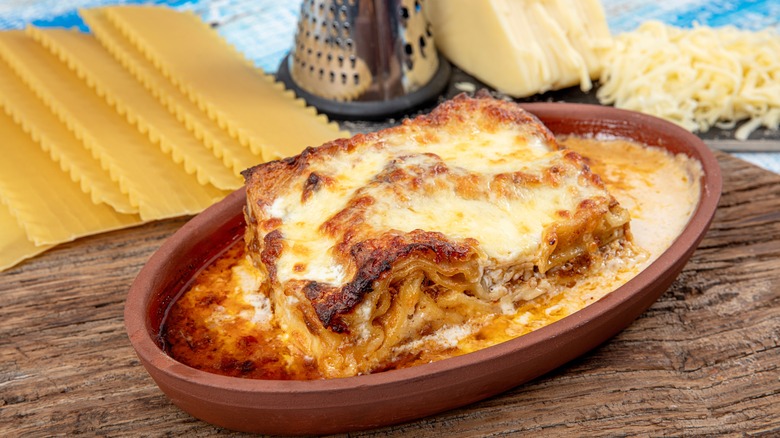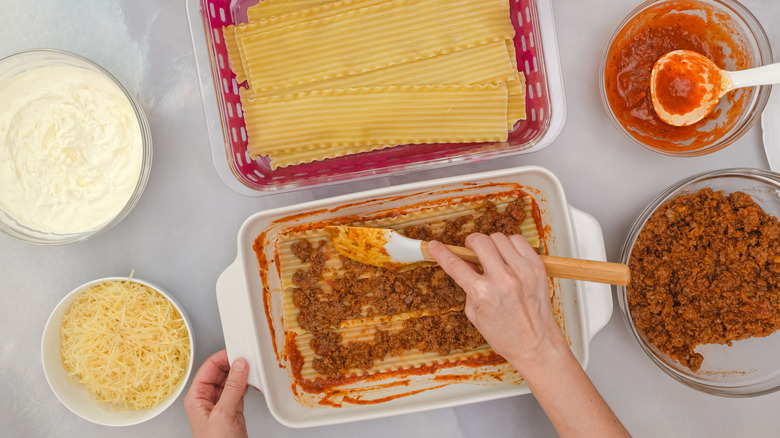Cut Down Your Cooking Time With Ina Garten's Lasagna Noodle Hack
At the risk of ruffling a few feathers, it may be time to update the family's lasagna recipe. While heirloom dishes reserve a special place in our hearts, Ina Garten has a hack that can improve the meal while simultaneously making it quicker to prepare — she simply soaks the noodles first.
The most time-consuming (and frustrating) step of preparing lasagna is pre-cooking the noodles. Traditionally, the dried pasta sheets are boiled in salty water, often resulting in an overcooked state, a common mistake when making lasagna. Flat sheets or curly-edged, the noodles undoubtedly stick together as they cook and easily tear when you try to separate them. Although many brands have created no-bake versions to simplify the process, this shortcut gets mushy in the oven and doesn't retain that desired toothsome bite between the layers.
Instead of wasting your time with other "solutions," like drizzling oil into the boiling water (which will also prevent the sauce from coating the surface), cooking noodles one at a time (who has time for that?), or maintaining a whirlpool of boiling water in the pot (an accident just waiting to happen), try Garten's hack.
She soaks a ½ pound of noodles in an oversized bowl filled with hot tap water for 20 minutes. Once drained, the pliable noodles are placed in a single layer on parchment paper until the dish is ready to be assembled. The best part is, it doesn't add any cooking time to the recipe.
Another time-saving tip for preparing lasagna
Similar to Ina Garten's lasagna noodle hack, you could also cut down your prep time by forgoing boiling water and cooking the pasta directly in the sauce — with minor recipe adjustments. If you're working with traditional dry noodles, not the no-bake or "oven-ready" varieties, you can assemble your favorite lasagna recipe using pasta that comes directly from the box. However, since the noodles are baked dry, you'll need to increase the amount of marinara sauce used in the recipe.
Normally, each lasagna layer should be well-balanced without adding too much of any one component, but dry noodles act like a sponge and absorb all the surrounding liquid. So, to rehydrate the pasta without leaving your lasagna overly dry, you'll need almost twice the amount of sauce (the idea is to have each sheet completely covered). This includes a thin layer on the bottom of the pan and another on top. Given the amount needed, you may want to use Garten's go-to jarred sauce, Raos, to cut prep time even further, rather than make it from scratch.
Before baking, securely cover the pan with aluminum foil to trap in steam. That additional moisture will help soften the pasta. Once the noodles are completely cooked, remove the foil to add a crispy finishing touch. Since the noodles cook in the sauce, expect a few extra minutes in the oven before the dish is fully baked.
Tips for preparing lasagna in advance
If prep time has prevented you from making more lasagnas, there are even more viable solutions that might change your mind. Unlike other recipes that dry out and become subpar versions, lasagna is actually better if it's prepared in advance, freeing you to make the dish when you have the time. This also means that you can double the recipe without doubling the work by preparing a second tray to enjoy later.
When you want to get all the work out of the way, lasagna can be baked, covered, and refrigerated for up to five days. This method gives you some versatility since you can slice yourself a single piece (without the filling oozing out) or reheat the entire covered tray until it's hot throughout. In addition, a fully cooked lasagna can be frozen for up to three months. Freeze it in double-wrapped individual slices or keep it whole.
If you are bringing the dish to a party, you can assemble the dish in the morning or the night before. Mary Berry prepares her lasagna this way, giving the uncooked noodles time to marinate in her flavorful sauce as it rests in the refrigerator. Since the lasagna is baked cold, you should expect a slightly longer cooking time; if it's frozen, expect roughly 30 additional minutes.



